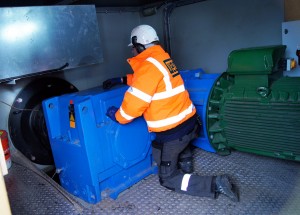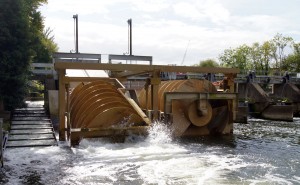WEG generators help to generate hydro-electricity in power generation project for Windsor Castle.
WEG Generators power Archimedes Screws to deliver energy to a mini power station to produce sustainable electricity for Windsor Castle. With a total project investment of 1.7 million, this hydroelectric project was the first of its kind, and it needed to pay off!
The scheme is the brainchild of David Dechambeau, Managing Director of Southeast Power Engineering. The power station consists of two Archimedes screws manufactured by Landustrie, each weighing 40 tonnes, connected to the WEG W22 IE3 class premium efficiency generators, which are now delivering 320kW/hr at peak flow, exceeding the original design criteria.
Watch Video overview of the project here:
The WEG Generators
The WEG W22 IE3 generators were designed and manufactured in Portugal at WEG's dedicated European manufacturing site; they are rated at 185kW and produce electricity at 400V, which is then fed via a 500kVA transformer to an underground line that connects to Windsor Castle as well as the National Grid.
The W22 units are specials in that they are generators based on a W22 motor, the reason being that in this application; when the screws need to be re-started, electricity is used to start the screws turning and then as the speed increases, so the motor function is changed over to a generator and the rotation of the screw is maintained by the water which in turn maintains the generator speed to produce the electricity.
Efficiency & Reliability
Efficiency was a key target for this application as the installation has a fixed ROI period, at 96% efficiency the WEG motor/generators represented one of the best investments Southeast Power could make in the power transmission design to ensure their six year ROI target was met.
David Dechambeau comments,
"In order to make this project sustainable, it was essential that we selected the most efficient equipment for the construction of this power station. The design called for a reliable generator with superior efficiency ratings and on balance the WEG component definitely fitted the criteria and it was straightforward to install."
David Dechambeau adds, "This is a very important project for us, not only because we are supplying the Royal Household, but also as an initial stepping stone for a number of similar projects. It is essential that we install the most efficient and ecologically sound power plant as possible. The work we are completing now will help to deliver future projects using similar technology as demand for sustainable power is understandably going to increase."
W22 sets the benchmark for affordable energy efficiency
The W22 motor sets the standard for affordable energy efficiency in the WEG range; while super-high efficiency IE4 motors are available, the IE3 standard offers 96% efficient W22 machines from fractional kW ratings to megawatt powers off-the-shelf. These machines, whether used as motors or adapted to become generators, satisfy an attractive balance between high efficiency, range, availability and value.
When you look at the total cost of ownership (TCO) for one of the machines over its lifetime the cost of acquisition typically represents only 1% of the total cost of ownership of an electric motor. In contrast, the associated energy savings provided by premium efficiency motors far outweigh this additional investment in purchase price, particularly in applications where the process operates on a 24hr basis.
What is next for Hydroelectricity projects
The royal household has agreed to buy the power generated by the Romney Weir generators, guaranteeing an income for the project. The Queen already has another hydroelectric plant in Balmoral and the Prince of Wales employs solar panels and wood chip boilers on his estate, the Archimedes screws however are the largest project so far and fit-in with a policy by the Royal Household to both cut bills and reduce its carbon footprint.
Estimates are that the hydroelectric generation capacity is equivalent to 1 million lb of coal per year, effectively reducing carbon dioxide emissions by more than 1,000 metric tonnes per year. The ecological side of the project goes further than just sustainable power generation though, with a new 'fish path' being been built alongside the weir to allow fish and eels to migrate up the river for the first time in centuries.
Get the latest process industry news
Interested in receiving even more industry-leading news from Process Industry Forum delivered directly to your inbox? Then sign up to our free newsletter. Bringing you the latest news, trends, innovations and opinion from across the process industry, our exclusive newsletter gives you all the industry insights of the moment in one, easy-to-digest bulletin. Stay ahead of the competition with regular process industry news instalments from PIF.



